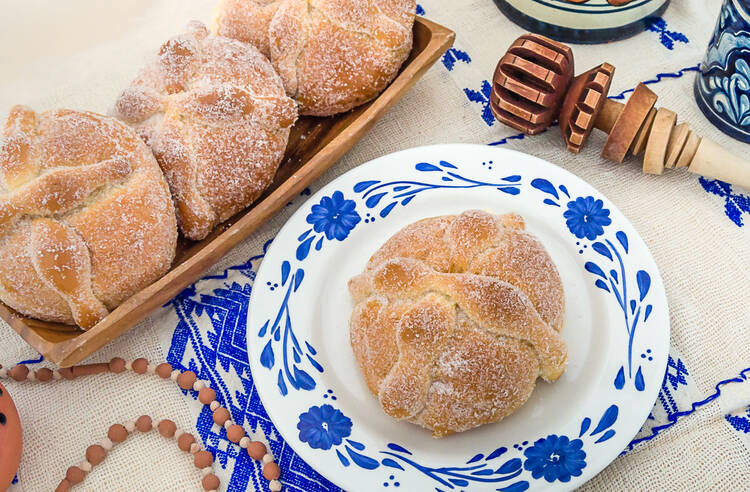I never had a reason to celebrate Día de los Muertos until rather recently. My abuelito was 79 years old when he passed away a month after he was diagnosed with liver cancer in 2017. He was one of the first people in my immediate family to pass away. He was a resilient man, my guerito. When I was 3 years old, he suffered a stroke that left him paralyzed on the left side. Subsequently, he suffered six more strokes. I did not have the pleasure of growing up with a grandfather who would sit me next to him and tell me stories of his childhood in Mexico or his time working as a bracero in El Norte.
What I did have was a pair of beautiful light green eyes that would light up whenever any of his 33 grandchildren walked in the room. He could not speak, could barely walk without a cane, but oh, did he try. He had a smile that had the power to turn your whole day around. He and my abuelita were married for over 60 years. They taught me the meaning of unconditional love, what it means to give of yourself completely, expecting absolutely nothing in return. Their love was true, good and beautiful.
What makes Pan de Muerto stand out is the shape: you prepare the bread to resemble a skull and bones.
My grandparents were the two people I could depend on to accompany me to Mass every week. Sunday after Sunday during the sign of peace, my grandpa would turn to us and reach out his one good arm to give us a tight squeeze and kiss on the cheek. He would ever so slowly make his way up the aisle during Communion, a tangible sign of hope that this faith life is hard but absolutely worth it.
It is a strange feeling when you don’t really grow up around death. You know death is real and is all around us, but when it does not affect your personally, it is like the dust bunnies you hide under the carpet when you have guests over. You’ll just worry about it later.
My grandpa’s diagnosis hit my family hard. One day my grandpa was fine, and the next he was bedridden, frail and jaundiced. Because of his paralyzation, he did not feel any pain, which is something I thank God for every day. I was not with my grandpa when he passed away, but I was lucky enough to spend his last birthday with him, a week before he died. We gathered around his bedside, sang him songs, cried, prayed and held each other as he stared at us through the tears in those beautiful green eyes.
Kneading the dough over and over again is my new rosary, and I desperately wish I could kiss him just one more time.
Two years later, I live in a different city, and I do not have the luxury of being able to visit his gravesite. I cannot hold his hand anymore or sit next to him as we drink my grandma’s cafecitocon leche. So, I do the next best thing: I bake.
Día de los Muertos has exploded in popularity recently. And no, it is not Mexican Halloween, as we wrote in America in 2017. It is a celebration of life and a reclaiming of death. Traditionally, families build an altar or shrine of their loved ones and decorate it with sugar skulls, papel picado, photos and, of course, food, usually some of their loved one’s favorite foods and candy. What is never missing from the shrine is Pan de Muerto, or Day of the Dead Bread.
Pan de Muerto is a Mexican sweet bread that is made specifically for Day of the Dead, as the name suggests. It is a basic recipe: flour, eggs, butter, sweet condensed milk, anise seeds. What makes Pan de Muerto stand out is the shape: you prepare the bread to resemble a skull and bones—reclaiming death.
For the past three Días de los Muertos, I have gotten to work. I purchase the anise seeds and prepare my baking surface. As I add the flour to wet ingredients and mix, I think of my grandfather and how I would give anything for one more squeeze of his hand. Kneading the dough over and over again is my new rosary, and I desperately wish I could kiss him just one more time. I’ll mold the bread to the proper shape, but, of course, it is never perfect. But that’s life. You try and fail and try again the next year. I bake the bread for 40 minutes total and my apartment fills with the aroma of home, family and love.
This Day of the Dead, I made two loaves of bread: one to share with colleagues and the less pretty one for myself and my grandpa to share over a cup of cafecito. I will watch “Coco” at home by myself and think of how much my grandpa would have enjoyed that movie. Maybe he will join me this year. Or maybe not. But I always carry a photo of him in my wallet and his love in my heart.
[Don’t miss more stories like this one. Sign up for our newsletter.]










I know the Day of the Dead has cultural meaning for Hispanic Catholics (and maybe even non-Catholic Hispanics), but why is it given such prominent play in America Magazine annually? The Church has had two days commemorating the dead (All Saints Day on November 1 and All Souls Day on November 2) *for all ethnicities* for well over a thousand years. Catholicism does not consist of just Hispanics, something America Magazine too often chooses to ignore.
Sorry if the "prominent play" of Latinos and our culture in America Magazine offends you. There's an article here about Latinos leaving the church. You may want to ask yourself if you are welcoming of non-white people, because it certainly doesn't feel like it in this letter. What if you, and those like you, are a driving force in the exodus?
Beautiful piece, Vivian. And to the nay-sayers I ask what they think about all the attention we give to St. Patrick's Day. America magazine does not ignore any culture - they embrace and celebrate everyone which is what Jesus calls us to do.
As a Catholic, there is All SAINTS Day and All SOULS Day - we do not indiscriminately lump together everyone who has died.
You are still in grief but it is really time to say "he died' and "he is dead".
It is also appropriate for you to accept the full separation, do not try to get his presence back, it is forbidden.
Remember, it is a holy and wholesome thought to pray FOR the dead that they may be loosed from their sins. (Maccabies)
What a lovely article, Ms Cabrera. Thank you for sharing the memory of your grandfather with us, and the way in which you remember him. Remembering our loved ones with gratitude, meditatively kneading a loaf of special bread to share is a sweet, meaningful custom. We do stay connected and pray with and for one another...
You might be horrified to learn that in some Mexican towns the church bells are rung ALL DAY LONG, to let everyone know the dead are now with us. Oh, the horrors of Mexican Catholicism!
Know your own history.
Spanish conquistadors took it over along with smallpox and other plagues. It is just another variant sprung from the pagan roots which originated Halloween.
And, I might add, I have no love of St Patrick's Day being one day during lent when you stop fasting and abstaining and get drunk. Very spiritual.
Ms. Cabrera, this is a lovely reflection of the memory of your grandfather. I enjoyed it very much. Please ignore the negative comments here and on Facebook. How anyone could take issue with this is beyond me. I am not Latino, but I appreciate the traditions of cultures besides my own and every year I learn more about this remembrance. I especially enjoyed your description of baking the sweetbread and likening the repetitive kneading to the repetitiveness of saying the rosary. Thank you for this beautiful article. I'm sorry that you lost someone you loved so much.